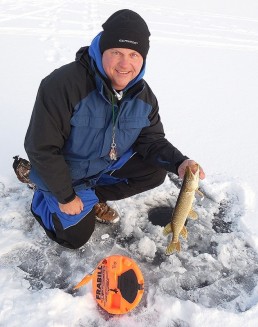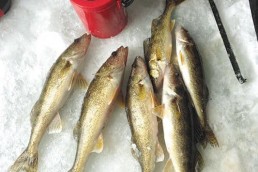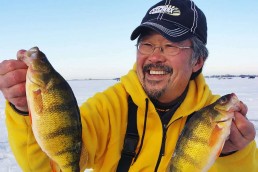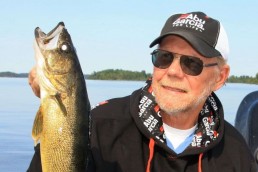‘Tipping up’ for Early-ice Pike and Walleyes
SHARE THIS POST
“Flag up!” yelled my fishing partner, as we both headed for the tip-up.
I lifted the round Frabill Pro Thermal Tip-Up off the hole, grabbed the line and snapped it tight. Then, a nice pike came up the hole and onto the ice. After a quick photo and release, I rebaited with a small sucker minnow and reset the tip-up. We were on a small metro-area lake the week before Christmas with about 6 inches of ice and no snow. The two of us had four tip-ups out along the top of the first drop-off from the shoreline flat of the small, weedy lake. The lake was full of pike, bass and panfish, so it was a natural target for early-ice pike. Spreading the tip-ups out along about 120 yards off the first break was the most efficient way to get baits in front of as many pike as possible. We were sitting in some comfortable lawn chairs, enjoying the sights and sounds of a beautiful evening while waiting for a flag to pop.
Early ice brings great fishing for all species, especially pike and walleyes. These are actively feeding relatively shallow in most lakes before thicker ice and snow cover kills off weeds, causing dissolved oxygen levels in the shallows to drop and the fish to drop to deeper water. Fish are often dispersed across flats and along breaklines during this time, unlike later in winter when they concentrate on more specific, deeper spots. If faced with this situation during the open-water season, most would not drop anchor and sit in one spot, hoping for fish to swim with them. Most of us would likely use a trolling approach for these scattered fish.
While we can’t troll once the lake is iced over, we can still spread out to cover water. Enter the tip-up. These allow a fisherman to spread lines out considerably, thus covering more of a flat or a breakline. Ice fishermen can see a flag pop up on a tip-up from a great distance and can watch as many tip-ups as regulations will allow in the state they’re fishing in. Several companies even make lights for tip-ups that attach to the flag and turn on when the flag pops up, allowing you to fish for scattered walleyes at night or in adverse conditions and still detect when you have a bite.
Tip-ups have evolved over the years. The newer, round, insulated models stack nicely in a 5-gallon bucket without tangling and cover and insulate a hole, reducing freeze-up and the need to clean out holes regularly. Several companies make this type of tip-up, and I like the Frabill Pro Thermal. Quality, tangle-free lines are also available from many companies to put on the spool of a tip-up, but if I’m targeting walleyes I like to use a fluorocarbon leader between the tip-up line and the bait. I have snap swivels tied to the end of the main line on all of my tip-ups too, allowing me to change leaders quickly. I have a variety of pre-tied leaders of fluorocarbon with a variety of hooks and jigs in walleye sizes intended for use with small- to medium-sized minnows. I also have several pre-tied leaders of 30-pound-test Clear Mist FireLine with larger hooks intended for medium to large minnows. I’ll use these for targeting the pike. I do have a few wire leaders pre-rigged for large minnows for the pike as well. I prefer rainbows and shiners for the walleyes, but fatheads will work. For pike, I mostly use sucker minnows. One trick for midwinter pike is to use a dead minnow or even a frozen smelt and set the bait to lie on the bottom. In mid- to late winter, pickings can get thin for predatory fish, and pike will often scavenge off the bottom. I’ve had many days in February where pike preferred this offering to other live minnow offerings we had down.
Are you enjoying this post?
You can be among the first to get the latest info on where to go, what to use and how to use it!
As mentioned, I like to target shoreline flats and the top edge of the first breakline for the pike and walleyes. If you can find areas with fairly sharp drop-offs to deeper water then you have found a good area. Fish will usually be scattered here this time of year, so put out as many tip-ups as regulations will allow, spread them out and stagger them between the shore and the breakline. Once you catch some fish and establish a pattern (closer to shore, mid-flat, right on top of the break), then duplicate that pattern with all of your tip-ups. When you find areas that produce fish, mark them, as they often will be good areas to try each year. If you are struggling to catch fish, try moving to the bottom of the break. Sometimes dissolved oxygen levels in a lake can have fish down deeper, even early in winter.
I like to stay outside this time of year, so my equipment consists of a sled, auger, sonar/GPS, fold-up lawn chair, portable grill and the tip-ups. I use a StikeMaster Lazer Mag 10 for my tip-up fishing. I like the larger hole for fighting and landing larger fish, and my StrikeMaster has never let me down. I’ll also use a Humminbird 688ci HD ice flasher and GPS combo. This allows me to find areas to drill holes and then check the depth and for any weeds once the hole’s drilled. I bring that comfortable lawn chair and portable grill because sometimes the bite can go on all day, and a lunch break of brats or burgers cooked on the ice is convenient.
While the fishing can be great during early ice, the ice conditions can be spotty. Be careful at all times and check with local bait shops and fishing guides because they know the area well and can get you the latest ice conditions. Pop holes to check ice thickness and bring a chisel to check the ice in front of you. In case you do fall through, always have a pair of ice picks hanging around your neck. I also like to wear a PFD just in case I wind up in the water. A smartphone in a sealed plastic bag in your chest coat pocket can also be a lifesaver in the event you fall through and you’re already hanging on a rope or anything else and need assistance, or, after you have just pulled yourself out and need medical attention.
On that December day on that small lake, we managed eight pike of varying sizes in the last hour-and-a-half before the beautiful sunset. So get out during the early-ice period this year and bring your tip-ups. Always use caution and common sense, and enjoy a nice day on the ice with some pike or walleyes hopefully caught to add to the enjoyment.
MWO
SHARE THIS POST
Did you enjoy this post?
You can be among the first to get the latest info on where to go, what to use and how to use it!
Troy Smutka
Troy Smutka is a central Minnesota fishing guide (greatdayonthewater.com) and a walleye tournament angler. He is also a member of the Lund Boats, Mercury Outboards and Johnson Outdoors Pro Teams, and hosts and produces Fishing and Hunting the North Country on YouTube.





